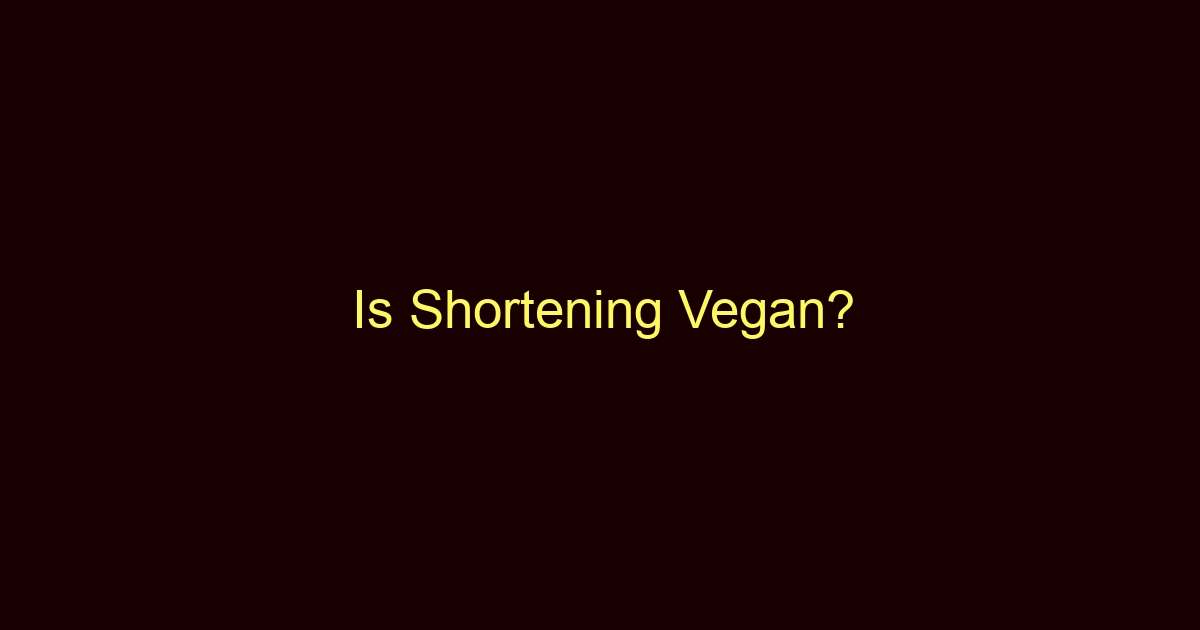Shortening, a form of fat popularly used in baking and frying, often raises questions regarding its compatibility with various diets, particularly veganism. Here, we explore what shortening is, its types, its uses, and whether it fits into a vegan diet.
What is Shortening?
Shortening is a type of fat used in cooking and baking. Its name derives from the way it interferes with the development of gluten, thus “shortening” the strands of protein in the dough and leading to a tender, crumbly texture in baked goods. Shortening is typically solid at room temperature, akin to butter, but has a higher melting point, which can contribute to specific desirable characteristics in culinary creations.
There are two main types of shortening: animal and vegetable. Animal shortening, often referred to as lard, is made from rendered animal fat, typically pork. It’s been used in cooking for centuries, prized for its ability to create flaky pastries and crisp fried foods.
What is Shortening made of?
Animal shortening, also known as lard, is derived from the fatty or adipose tissue of pigs. During the rendering process, the fat is heated to separate it from the connective tissue. The resulting product is a creamy white substance with a slightly meaty flavor. Lard is a highly saturated fat, which is why it remains solid at room temperature.
On the other hand, vegetable shortening is made from various plant oils like soybean, cottonseed, or palm oil. These oils are naturally liquid at room temperature, so they undergo a process called hydrogenation. Hydrogenation involves the addition of hydrogen atoms to the fat molecules, which saturates the previously unsaturated fats, making them solid at room temperature. Vegetable shortening is a commonly used vegan substitute for lard in recipes.
What is Shortening used for?
Shortening has several uses in the culinary world. It’s primarily used in baking because it helps inhibit gluten formation, making pastries more tender and flaky. It’s the secret to making pie crusts flaky, cookies crumbly, and biscuits fluffy.
Shortening is also used for frying, as it has a high smoke point and doesn’t impart a strong flavor to the food. This allows the flavors of the food being fried to shine through. Moreover, due to its high melting point, shortening helps maintain the structure of baked goods better than butter, which is particularly useful in warm climates.
What Foods Contain Shortening?
Shortening is found in a variety of baked goods, including pies, biscuits, and cookies. It’s also commonly used in fried foods, such as donuts and french fries. In the commercial food industry, shortening is often used because it’s less expensive and has a longer shelf life than butter.
Is Shortening Vegan?
The vegan status of shortening depends on its type. Animal shortening, such as lard, is not vegan, as it’s derived from animal fat. Conversely, vegetable shortening, which is derived from plant oils, is typically vegan. However, it’s essential for vegans to check labels as some brands of vegetable shortening may contain mono and diglycerides, which can be derived from either plant or animal sources.
Vegans exclude animal-derived products for various reasons, including ethical concerns, health benefits, and environmental sustainability. As such, products like lard are excluded from a vegan diet, while vegetable shortening is generally acceptable.
Can vegans eat Shortening and why?
Vegans can consume vegetable shortening as it’s derived from plant-based oils. It’s a useful ingredient for vegan baking, offering a substitute for butter or lard to achieve the desired texture in baked goods. However, as mentioned, it’s crucial for vegans to read product labels to ensure there are no hidden animal-derived ingredients.
Is Shortening Healthy?
The healthiness of shortening is somewhat controversial. While it’s true that vegetable shortening contains unsaturated fats, which are generally healthier than saturated fats, it’s also often high in trans fats due to the hydrogenation process. Trans fats are associated with increased risks of heart disease and other health problems. Therefore, while shortening can be a part of a balanced diet, it should be used in moderation.
Is Shortening Gluten-Free?
Yes, shortening is naturally gluten-free, as it’s derived from fat, not a grain. This makes it suitable for those with celiac disease or a gluten intolerance. However, always check the labels for any possible cross-contamination warnings if you’re highly sensitive to gluten.
Can You Cook with Shortening?
Yes, you can cook with shortening. It has a high smoke point, making it suitable for frying. It’s also commonly used in baking to achieve a specific texture in pastries. However, because it’s flavorless, it may not be the best choice for recipes where the fat contributes to the overall taste, such as in butter cookies or cakes.
Is Shortening Safe?
Shortening is generally safe to consume. However, as with any food product, individual reactions can vary. Those with allergies to the specific oils used in vegetable shortening should avoid it. Also, due to its high calorie content, excessive consumption could contribute to weight gain and associated health issues. As always, moderation is advised.
Final Thoughts
In conclusion, while animal shortening is not vegan, vegetable shortening is usually a safe choice for those following a vegan diet. It’s a handy ingredient in vegan baking, allowing the creation of tender, flaky pastries without the use of animal-derived fats.
However, it’s important to check the product label for any non-vegan additives. Health-wise, the presence of trans fats in many shortenings means that they should be consumed sparingly. Overall, vegetable shortening can be a useful tool in a vegan baker’s arsenal, providing it’s used wisely and in moderation.

